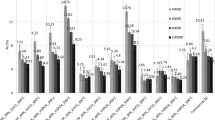Abstract
Effects of adsorbent treatments used for reduction of benzo(a)pyrene (BaP) levels in volatile profiles and sesamol and sesamolin antioxidant contents in sesame oil were evaluated. Charcoal-based activated carbons with different mesh sizes and celite were used as adsorbents. Treatment with activated carbons led to reductions in BaP contents of sesame oil. A small charcoal-based activated carbon particle size was more effective for removal of BaP. Celite; however, did not show an effect on the BaP content of sesame oil under the experimental conditions. Volatile profiles of sesame oil were not influenced by addition of any adsorbent, and the sesamol and sesamolin contents were reduced by all adsorbents.
Similar content being viewed by others
References
Benner BA, Gordon GE, Wise SA. Mobile sources of atmospheric polycyclic aromatic hydrocarbons: A roadway tunnel study. Environ. Sci. Technol. 23: 1269–1278 (1989)
Mannino MR, Orecchio S. Polycyclic aromatic hydrocarbons (PAHs) in indoor dust matter of Palermo (Italy) area: Extraction, GC-MS analysis, distribution and sources. Atmos. Environ. 42: 1801–1817 (2008)
International agency for research on cancer (IARC). IARC monographs on the evaluation of carcinogenic risks to humans. IARC, Lyon, France (2004)
Butler JP, Post GB, Lioy PJ, Waldman JM, Greenberg A. Assessment of carcinogenic risk from personal exposure to benzo(a)pyrene in the total human environmental exposure study (THEES). JAPCA J. Air Waste Ma. 43: 970–977 (1993)
Phillips DH. Polycyclic aromatic hydrocarbons in the diet. Mutat. Res. 443: 139–147 (1999)
Teixeira VH, Casal S, Oliveira M. PAHs content in sunflower, soybean and virgin olive oils: Evaluation in commercial samples and during refining process. Food Chem. 104: 106–112 (2007)
Kazerouni N, Sinha R, Hsu C, Greenberg A, Rothman N. Analysis of 200 food items for benzo [a] pyrene and estimation of its intake in an epidemiologic study. Food Chem. Toxicol. 39: 423–436 (2001)
Šimko P. Determination of polycyclic aromatic hydrocarbons in smoked meat products and smoke flavouring food additives. J. Chromatogr. B. 770: 3–18 (2002)
Dennis M, Massey R, Cripps G, Venn I, Howarth N, Lee G. Factors affecting the polycyclic aromatic hydrocarbon content of cereals, fats andother food products. Food Addit. Contam. 8: 517–530 (1991)
Speer K, Steeg E, Horstmann P, Kühn T, Montag A. Determination and distribution of polycyclic aromatic hydrocarbons in native vegetableoils, smoked fish products, mussels and oysters, and bream from the river elbe. J. High Res. Chromatog. 13: 104–111 (1990)
Larsson B, Eriksson A, Cervenka M. Polycyclic aromatic hydrocarbons in crude and deodorized vegetable oils. J. Am. Oil Chem. Soc. 64: 365–370 (1987)
Orruno E, Morgan M. Purification and characterisation of the 7S globulin storage protein from sesame (Sesamum Indicum L.). Food Chem. 100: 926–934 (2007)
Rangkadilok N, Pholphana N, Mahidol C, Wongyai W, Saengsooksree K, Nookabkaew S, Satayavivad J. Variation of sesamin, sesamolin and tocopherols in sesame (Sesamum Indicum L.) seeds and oil products in Thailand. Food Chem. 122: 724–730 (2010)
Fukuda Y, Nagata M, Osawa T, Namiki M. Chemical aspects of the antioxidative activity of roasted sesame seed oil, and the effect of using the oil for frying. Agr. Biol. Chem. Tokyo 50: 857–862 (1986)
Kaur IP, Saini A. Sesamol exhibits antimutagenic activity against oxygen species mediated mutagenicity. Mutat. Res. 470: 71–76 (2000)
Fukuda Y, Nagata M, Osawa T, Namiki M. Contribution of lignan analogues to antioxidative activity of refined unroasted sesame seed oil. J. Am. Oil Chem. Soc. 63: 1027–1031 (1986)
Seo I, Nam H, Shin H. Influence of polycyclic aromatic hydrocarbons formation in sesame oils with different roasting conditions. Korean J. Food Sci. Technol. 41: 355–361 (2009)
Choi SK, Choe SB, Kang ST. Reduction of benzo(a)Pyrene content in sesame oil by using adsorbents. J. Korean Soc. Food Sci. Nutr. 43: 564–569 (2014)
Mastral A, García T, Callén M, Murillo R, Navarro M, López J. Sorbent characteristics influence on the adsorption of PAC: I. PAH adsorption with the same number of rings. Fuel Process. Technol. 77: 373–379 (2002)
Liu Z. Control of PAHs from incineration by activated carbon fibers. J. Environ. Eng. 132: 463–469 (2006)
Chiang B, Wey M, Yang W. Control of Incinerator organics by fluidized bed activated carbon adsorber. J. Environ. Eng. 126: 985–992 (2000)
Souchon I, Rojas J, Voilley A, Grevillot G. Trapping of aromatic compounds by adsorption on hydrophobic sorbents. Sep. Sci. Technol. 31: 2473–2491 (1996)
Villacañas F, Pereira MFR, Órfão JJ, Figueiredo JL. Adsorption of simple aromatic compounds on activated carbons. J. Colloid Interf. Sci. 293: 128–136 (2006)
Erdem E, Çölgeçen G, Donat R. The removal of textile dyes by diatomite earth. J. Colloid Interf. Sci. 282: 314–319 (2005)
Karanfil T, Kilduff JE. Role of granular Activated carbon surface chemistry on the adsorption of organic compounds. 1. Priority pollutants. Environ. Sci. Technol. 33: 3217–3224 (1999)
Al-Ghouti M, Khraisheh M, Allen S, Ahmad M. The removal of dyes from textile wastewater: A study of the physical characteristics and adsorption mechanisms of diatomaceous earth. J. Environ. Manage. 69: 229–238 (2003)
Ahn CK, Kim YM, Woo SH, Park JM. Selective adsorption of phenanthrene dissolved in surfactant solution using activated carbon. Chemosphere 69: 1681–1688 (2007)
Newcombe G, Drikas M, Assemi S, Beckett R. Influence of characterised natural organic material on activated carbon adsorption: I. Characterisation of concentrated reservoir water. Water Res. 31: 965–972 (1997)
Lin C, Cheng Y, Liu Z, Chen J. Metal catalysts supported on activated carbon fibers for removal of polycyclic aromatic hydrocarbons from Incineration flue gas. J. Hazard. Mater. 197: 254–263 (2011)
Shimoda M, Shiratsuchi H, Nakada Y, Wu Y, Osajima Y. Identification and sensory characterization of volatile flavor compounds in sesame seed oil. J. Agr. Food Chem. 44: 3909–3912 (1996)
Kim EY. Trial reduce PAHs contents in the process of sesame oil. MS thesis, Kyungpook National University, Daegu, Korea (2012)
Author information
Authors and Affiliations
Corresponding author
Rights and permissions
About this article
Cite this article
Shin, B.R., Yang, SO., Song, HW. et al. Effects of adsorbents on benzo(a)pyrene, sesamol, and sesamolin contents and volatile component profiles in sesame oil. Food Sci Biotechnol 24, 2017–2022 (2015). https://doi.org/10.1007/s10068-015-0266-x
Received:
Revised:
Accepted:
Published:
Issue Date:
DOI: https://doi.org/10.1007/s10068-015-0266-x




